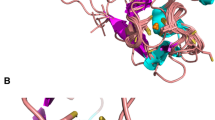Abstract
Desulforedoxin is a simple dimeric protein isolated from Desulfovibrio gigas containing a distorted rubredoxin-like center with one iron coordinated by four cysteinyl residues (7.9 kDa with a 36-amino-acid monomer). 1H NMR spectra of the oxidized Dx(Fe3+) and reduced Dx(Fe2+) forms were analyzed. The spectra show substantial line broadening due to the paramagnetism of iron. However, very low-field-shifted resonances, assigned to Hβ protons, were observed in the reduced state and their temperature dependence analyzed. The active site of Dx was reconstituted with zinc, and its solution structure was determined using 2D NMR methods. This diamagnetic form gave high-resolution NMR data enabling the identification of all the amino acid spin systems. Sequential assignment and the determination of secondary structural elements was attempted using 2D NOESY experiments. However, because of the symmetrical dimer nature of the protein standard, NMR sequential assignment methods could not resolve all cross peaks due to inter- and intra-chain effects. The X-ray structure enabled the spatial relationship between the monomers to be obtained, and resolved the assignment problems. Secondary structural features could be identified from the NMR data; an antiparallel β-sheet running from D5 to V18 with a well-defined β-turn around cysteines C9 and C12. The section G22 to T25 is poorly defined by the NMR data and is followed by a turn around V27-C29. The C-terminus ends up near residues V6 and Y7. Distance geometry (DG) calculations allowed families of structures to be generated from the NMR data. A family of structures with a low target function violation for the Dx monomer and dimer were found to have secondary structural elements identical to those seen in the X-ray structure. The amide protons for G4, D5, G13, L11 NH and Q14 NHε amide protons, H-bonded in the X-ray structure, were not seen by NMR as slowly exchanging, while structural disorder at the N-terminus, for the backbone at E10 and for the section G22–T25, was observed. Comparison between the Fe and Zn forms of Dx suggests that metal substitution does not have an effect on the structure of the protein.
Similar content being viewed by others
Author information
Authors and Affiliations
Additional information
Received: 19 July 1995 / Accepted: 22 April 1996
Rights and permissions
About this article
Cite this article
Goodfellow, B., Tavares, P., Romão, M. et al. The solution structure of desulforedoxin, a simple iron-sulfur protein . JBIC 1, 341–354 (1996). https://doi.org/10.1007/s007750050062
Issue Date:
DOI: https://doi.org/10.1007/s007750050062




